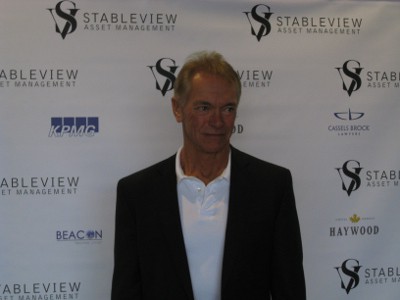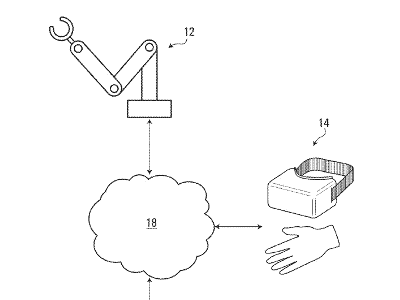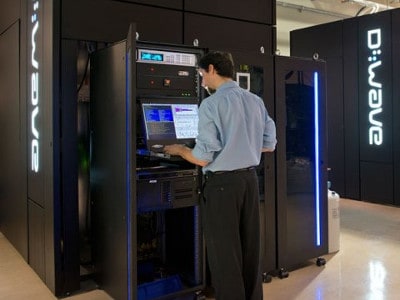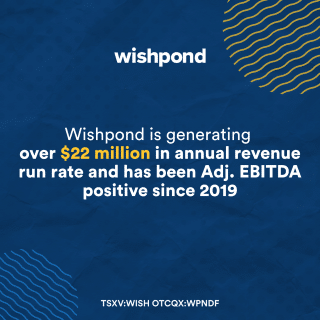

Burnaby-based D-Wave Systems, who are building “quantum” computers, delivered a presentation at StableView Asset Management’s TECH15 conference in Toronto today.
If it looks slightly fishy to qualify D-Wave’s quantum computer with quotation marks, it’s simply because most scientists believe that a true quantum computer is physically impossible.
D-Wave, however, has built a computer that behaves with quantum characteristics and for all intents and purposes is as close to an actual quantum computer as we’re likely to get, and will only get more so as D-Wave’s technology advances.
President Bo Ewald estimates that D-Wave is now where the supercomputer was in 1980, or where IBM was in 1955.
Founded in 1999, D-Wave has been granted over 125 U.S. patents and has published over 80 articles in scientific journals and has raised $175 million to date.
To a room full of Bay Street investors, Ewald’s opening gambit is powerful. “If you knew back in the 1950s that there was a company called International Business Machines manufacturing vacuum tubes and computer processors, would you have invested in them?”
Suggesting that D-Wave’s potential represents an equally great market opportunity, given that it represents nothing less than the future of computing, he then goes on to outline the mind-warping technology behind D-Wave’s computer.
The implications offered by D-Wave’s technology will have significant impact on computing tasks that are currently rudimentary by quantum standards.
While the market for who can own D-Wave’s computer is limited by the physical limitations of running the machine, Google has just renewed their agreement with D-Wave for the next seven years.
Last month, D-Wave updated the Google computer, located at the NASA Ames Research Center, upgrading it from 512 qubits to over 1,000.
While the D-Wave 2X’s processor is itself only thumbnail sized, the computer’s housing takes up a 10′ x 7′ x 10′ footprint, mainly comprised of a cryogenic refrigeration system.
Furthermore, the computer must operate in an extremely isolated environment, free from interference from magnetic fields, vibration, or any external RF signals.
Google’s interest in D-Wave is partly in its capacity to advance its machine learning capabilities, which you can see the current limitations of if you use Google Translate, for example.
“The question for investors is, when is the right time to get into this? But it is going to be in your future.” – Bo Ewald
In May 2013, the company sold a 512 qubit D-Wave Two model to NASA and Google for approximately $15 million.
To test the machine, Ewald tells the crowd, Google created a couple of benchmark problems for D-Wave’s computer to solve.
The original 512 qubit processor in that computer was not markedly better performing than a standard computer, a result that has dogged D-Wave over the past two years and has fed skepticism over the technology’s potential.
Recently, though, it was found that Google’s benchmark was solved by D-Wave’s latest processor about 10,000 times faster than a standard computer, obviously a massive performance envelope improvement.
“If we can figure out how to use this machine,” Google reportedly told D-Wave, “it’s going to have tremendous impact on solving some our problems of interest.”
Potential future clients apart from Lockheed and Google include the defense and intelligence industries, as well as national laboratories, universities and private companies that conduct intensive research.
And while D-Wave is known for building hardware, it is in software development that part of the company’s future revenue lies, both in licensing software and with an eventual objective of building a cloud model, which Ewald says hold 50% margins for the business.
Ewald tells the story of meeting with the head of a large German technology company and several of his company’s employees in attendance, who said at the end, “This is the meeting we will tell our grandchildren about. This is the meeting where we decided to get into quantum computing.”
The company’s technology covers a wide variety of applications, including minimizing error in voice recognition, controlling risk in a financial portfolio, or reducing loss in an energy grid.
Asked by an audience member about the difference between D-Wave’s computer and IBM’s effort at quantum computing, Ewald responds, “Without wanting to be a smart alec about it, ours works,” at which point he goes into painstaking technical detail regarding how the machine does what it does.
Finishing his talk, Ewald matter-of-factly assesses the potential for investors, which the room happens to be full of, by asserting that his technology represents nothing less than the future of computing.
“This is something that’s going to be in your future,” he says. “So the question for investors is, when is the right time to get into this? But it is going to be in your future.”
Leave a Reply
You must be logged in to post a comment.






 Share
Share Tweet
Tweet Share
Share




Comment